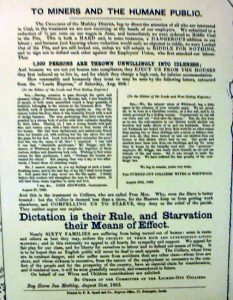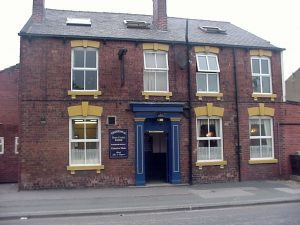A printed poster on view at the National Mining Museum at Caphouse Colliery describes the dreadful state of industrial relations in and around Methley at this time.
This was a situation brought about by adverse trading conditions in coal mining at the time, subsequent cost cutting steps imposed by the mine owners (Briggs’) and the resulting hardship suffered by the coal miners involved and their families in Methley and the adjacent village of Whitwood.
The poster (appended here) was in the form of a plea to the general public to understand the position that miners had found themselves in and the actions that were being taken by the owners.
The build up to the dispute began in the June of that year when the men, having had to accept a reduction of seven and half percent on wages refused a later request to riddle (screen) the coal before filling the tubs. As a result of this refusal the men were then locked out having also refused to sign not to defend each other (form an association with representation).
One witness writing to the Leeds Express reported seeing hundreds of men and women along with their furniture being ejected from their homes at Common Row, Whitwood. The bailiffs in this work being guarded by a strong force of police armed with cutlasses.
Similar action was taking place in Methley as extracts from the churchside school logbooks reproduced in Jim Melvin’s book Methley 2000 confirm:-
16th July – All the pits are closed, strike likely to prove serious.
15th Sept – Mr. Briggs the coal proprietor has turned parents and children out of
his houses and great destitution has been caused.
17th Nov – Increase in attendance as some colliers return to work.
25th Nov – Effects of the strike still very detrimental.
11th Dec – Colliers working much better.
5th Jan – The colliers are now returned to regular work.
Of equal significance to the melodrama described by the poster is the postal address of the Committee of Locked-out Colliers which was the Bay Horse Inn, Methley. From this we can deduce that the pub was more than a watering place. As meetings were taking place there (as they did right up to the 1970’s) it was clearly becoming one foundation of the developing Miner’s Association.
After failure in earlier years by the Chartists to secure representation and organisation for workmen from the top downwards, it is possible to see that association developed from the bottom upwards and the Bay Horse at Methley would be a factor in the development of early representation for miners. (The West Yorkshire Miners’ Association was formed in 1863 – it takes little imagination to work out where the originations for this type of association originated).
 The structure of the later Yorkshire Miners Association in 1881 and then NUM was certainly an amalgamation of like groups.
The structure of the later Yorkshire Miners Association in 1881 and then NUM was certainly an amalgamation of like groups.
One is left to wonder if Samuel Poppleton the landlord of the Bay Horse at this time could have envisaged the role of his public house towards that end.
Doubtless he would have simply been pleased to get the business of those thirsty colliers in his premises.